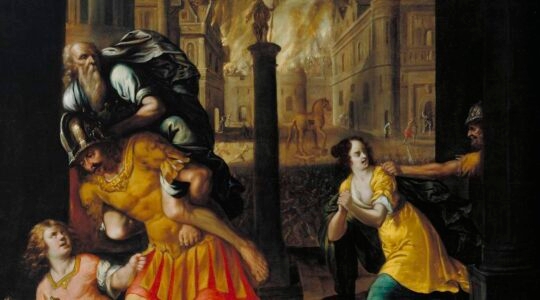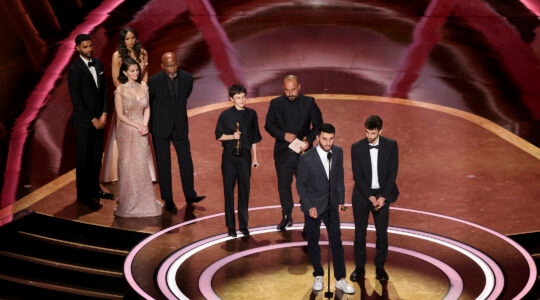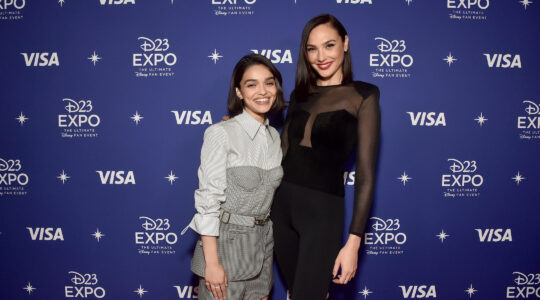NETANYA, Israel (JTA) – On one side of the cavernous gym, six members of Israel’s first Olympic rhythmic gymnastics team warm up in a circle, chatting softly in a mix of Russian and Hebrew while stretching their legs in effortless splits on the mat.
Nearby, Irina Risenzon, a fellow gymnast competing in the individual category, is trying to master a leap in which her head must tilt backward to meet a bent leg.
It’s late afternoon and the young women, ranging in age from 17 to 22, have been practicing for much of the day. In black T-shirts and black shorts, they appear to be in uniform, reinforcing a feeling of discipline and order that marks their training and routines.
“There are harder workouts and easier ones,” says Risenzon, 20, her auburn hair pulled into a bun. She sits on a wooden bench on the edge of the gym, watching the team begin its routine. The gymnasts practice about 10 hours per day.
“But you know why you are here,” she says. “For me it’s my goal: the Olympics.”
Like every Olympian, her ultimate goal is the gold.
“That’s the dream,” Risenzon says, breaking into a smile, a marked contrast from the grimace she’s been wearing for the past two hours while trying to perfect her leaps and pivots before her hard-driving coach, Ira Vigdorchik.
Risenzon has been training with Vigdorchik since she was 9, the same year she and her family immigrated to Israel from Ukraine.
The language in the hall is predominately Russian; six of the eight rhythmic gymnasts are immigrants from the former Soviet Union. The two Israel natives are the daughters of immigrants: Rachel Vigdorchik, who tutors Risenzon, and Neta Rivkin, who at 17 is the youngest member of the Israeli Olympic team.
This large contingent of rhythmic gymnasts is why the Israeli squad has nearly as many women as men this year in its 39-member delegation for the Olympics in China.
The sport combines ballet, theatrical dance and gymnastics and is divided into individual, pair and team event categories. Ropes, hoops, balls, clubs and ribbons are used in the routines.
About 3,000 girls are training in gyms across the country, according to Rachel Vigdorchik. She oversees 300 of them at the gym she runs in Holon and at another branch in Jaffa for Arab girls.
Vigdorchick, who moved to Israel in 1979, was scheduled to perform in the 1980 Olympic Games in Moscow, her hometown, but she stayed home when the Israeli team boycotted, along with other countries, in protest of the Soviet invasion of Afghanistan.
Looking around the gym at the team members she has coached, most of them since they were little girls, Vigdorchick says they’re like family. She says this year’s Olympics Games are “closing a circle.”
Vigdorchik says she’s proud that rhythmic gymnastics, a sport brought to Israel by Russian immigrants in the early 1970s, has caught on.
“It’s very popular, but we need more government investment and more sponsors,” she says, echoing a common complaint of Israel’s sporting community.
For those who grew up in the Soviet system, where cultivating sports and athletes was a top national priority, the contrast in Israel can be jarring.
Ela Samotalov, the coach for the team event, came in 1991 from Minsk, where she helped coach the Belarus national team. She says she is still getting accustomed to Israel’s more spartan sports culture.
“There is no status to being a coach here in Israel,” she complains.
The Soviet-style training, with its strict discipline and demands, can seem off-putting to native-born Israelis, Samotalov says. This is part of what unites the Russian-born gymnasts – a shared understanding of the dedication needed to excel that comes from growing up in families versed in a more intense approach to sports.
“But the sabras are learning well; it will just take time,” Samotalov says of the Israelis. “Sports is not a miracle. It’s hard work.”
Samotalov is encouraged by the homegrown talent of one of her longtime charges, Rivkin, 17, who has improved consistently at competitions this year.
“My goal is to do the best I can,” Rivkin says of Beijing. “It’s so special, going out there in front of that huge audience.”
Not far away, Risenzon laughs as she recalls her introduction to the sport when she was a little girl living near Kiev.
“I was considered sickly, always getting the flu,” she recalls. “So my parents were told that to strengthen my body I should do sports, and the closest gym to our house was for rhythmic gymnastics.”
When she was 4, Risenzon’s Olympic career was nearly derailed by coaches who deemed her too pudgy to excel in the sport. Her baby fat long gone, she finished seventh last September in the World Championships.
Risenzon talks about the deep concentration she tries to maintain during her routines – tuning out the clapping crowds, the cameras and the competition. Relief and satisfaction come only after a successful routine is completed.
“Then I think about everything,” she says. “In the midst of it all I’m focused on the next move.”
“But I love to perform,” Risenzon says, her deep brown eyes shining as she describes her Olympic routines, which include a playful number set to Indian music and another with a samba tune.
Despite her immigrant origins, she has no identity dilemmas, she says. “I’ve felt deeply connected here,” Risenzon says, “and when I see the Israeli flag flying I get goose bumps.”
JTA has documented Jewish history in real-time for over a century. Keep our journalism strong by joining us in supporting independent, award-winning reporting.





